Vinyl records are making a comeback, and collectors know the importance of proper storage. At Outbuilders, we understand the passion for preserving these musical treasures.
In this post, we’ll explore vinyl album storage solutions that protect your collection from damage and deterioration. From ideal environmental conditions to practical storage options, we’ve got you covered.
How to Create the Perfect Environment for Vinyl Storage
The Goldilocks Zone for Temperature and Humidity
Your records thrive in a stable environment. Try to maintain a temperature between 65°F and 70°F (18°C to 21°C). Humidity plays an equally important role – keep it between 45% and 50%. Avoid fluctuations at all costs. Purchase a reliable thermometer and hygrometer to monitor these conditions. Place them near your collection and check them regularly.
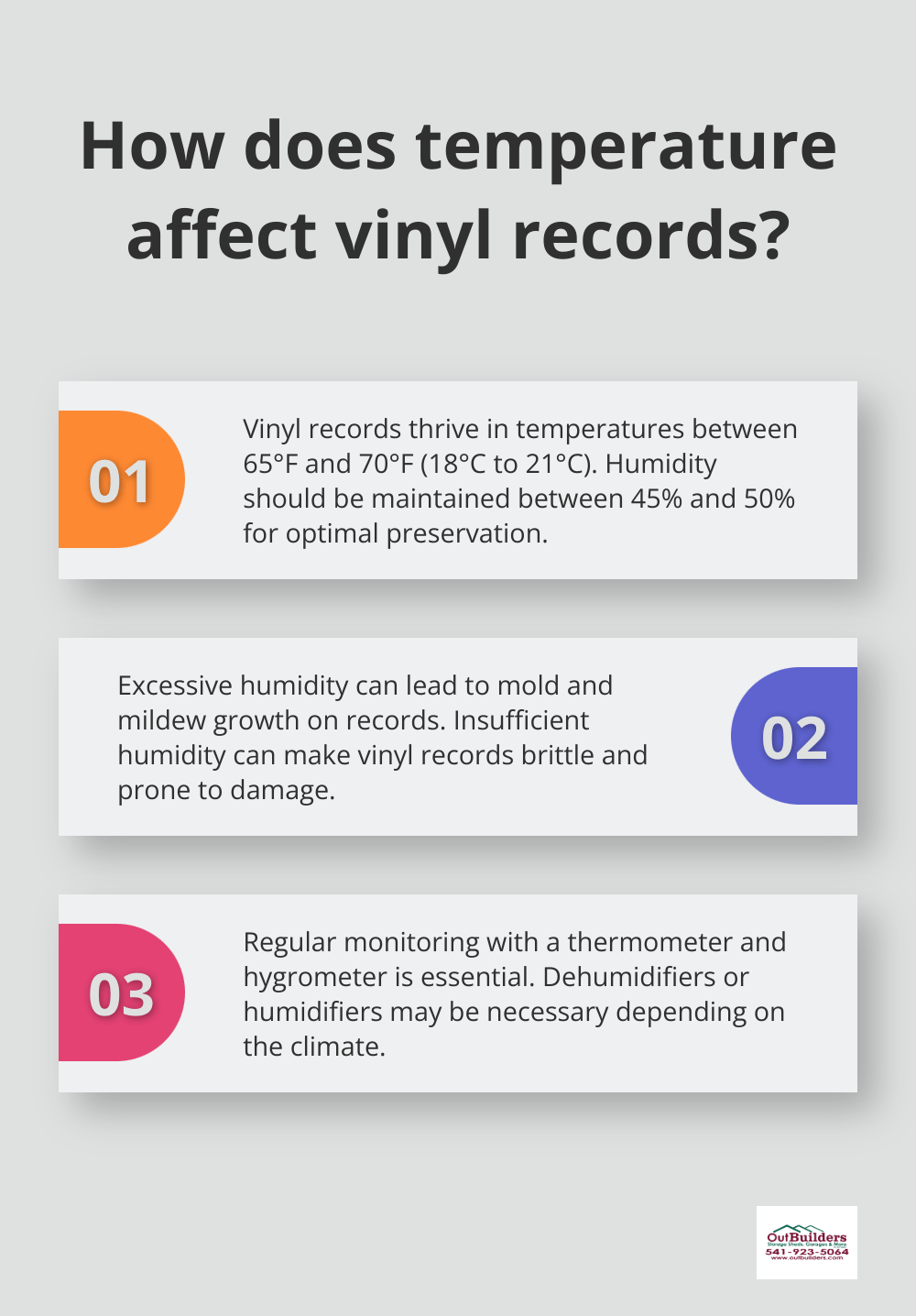
Excessive humidity can lead to mold and mildew growth, while insufficient humidity can make your records brittle. If you live in a particularly humid area, a dehumidifier might be necessary. In dry climates, a humidifier could help maintain the ideal conditions. Consistency is the key to preserving your vinyl collection.
Shield Your Collection from Light and Heat
Sunlight is not your vinyl’s friend. UV rays can warp records and fade album covers. Store your collection away from windows and use curtains or blinds to block out direct sunlight. If you display albums, use UV-resistant frames or sleeves to protect them.
Heat sources like radiators, vents, and electronics can also damage your records. Keep your storage area at least a few feet away from these potential hazards. Custom storage solutions can help design a space that naturally protects your collection from these threats.
Wage War on Dust and Debris
Dust is more than just an annoyance – it can seriously impact sound quality. Store your records as close to vertical as possible to prevent warping. Use high-quality, anti-static inner sleeves for each record. Outer sleeves add an extra layer of protection (and they look great, too!).
Clean your records regularly. Invest in a carbon fiber brush for light dusting before and after each play. For deeper cleaning, use a specialized vinyl cleaning solution and microfiber cloth. Never apply household cleaners to your records – they can cause irreparable damage.
Consider a closed storage system to minimize dust exposure. If you prefer open shelving, dust the entire area regularly. A small air purifier near your collection can also help keep airborne particles at bay.
Organize for Optimal Protection
Proper organization not only makes your collection look great but also protects your records. Use dividers to separate genres or artists, reducing the risk of records rubbing against each other. Consider alphabetizing or using a cataloging system to minimize handling when searching for a specific album.
Store records of similar sizes together. Mixing 7-inch singles with 12-inch LPs can lead to uneven pressure and potential warping. If you have particularly valuable or rare records, consider giving them their own dedicated space with extra protection.
The effort you put into creating the perfect storage environment will pay off in preserved sound quality and album longevity. With these conditions in place, you’re ready to explore the various storage solutions available for your growing vinyl collection.
How to Choose the Best Vinyl Storage Solutions
When it comes to protecting your vinyl collection, the right storage solution can make all the difference. Let’s explore some practical options that cater to different needs and preferences.
Custom Shelving Units: A Perfect Fit for Your Collection
Custom shelving units are an excellent investment for serious collectors. These units can be tailored to fit your space and collection size perfectly. The IKEA Kallax series is a popular choice among vinyl enthusiasts due to its ideal cube size for LPs. However, for a more personalized touch, you should consider working with a local carpenter to create a bespoke unit that matches your home’s aesthetic.
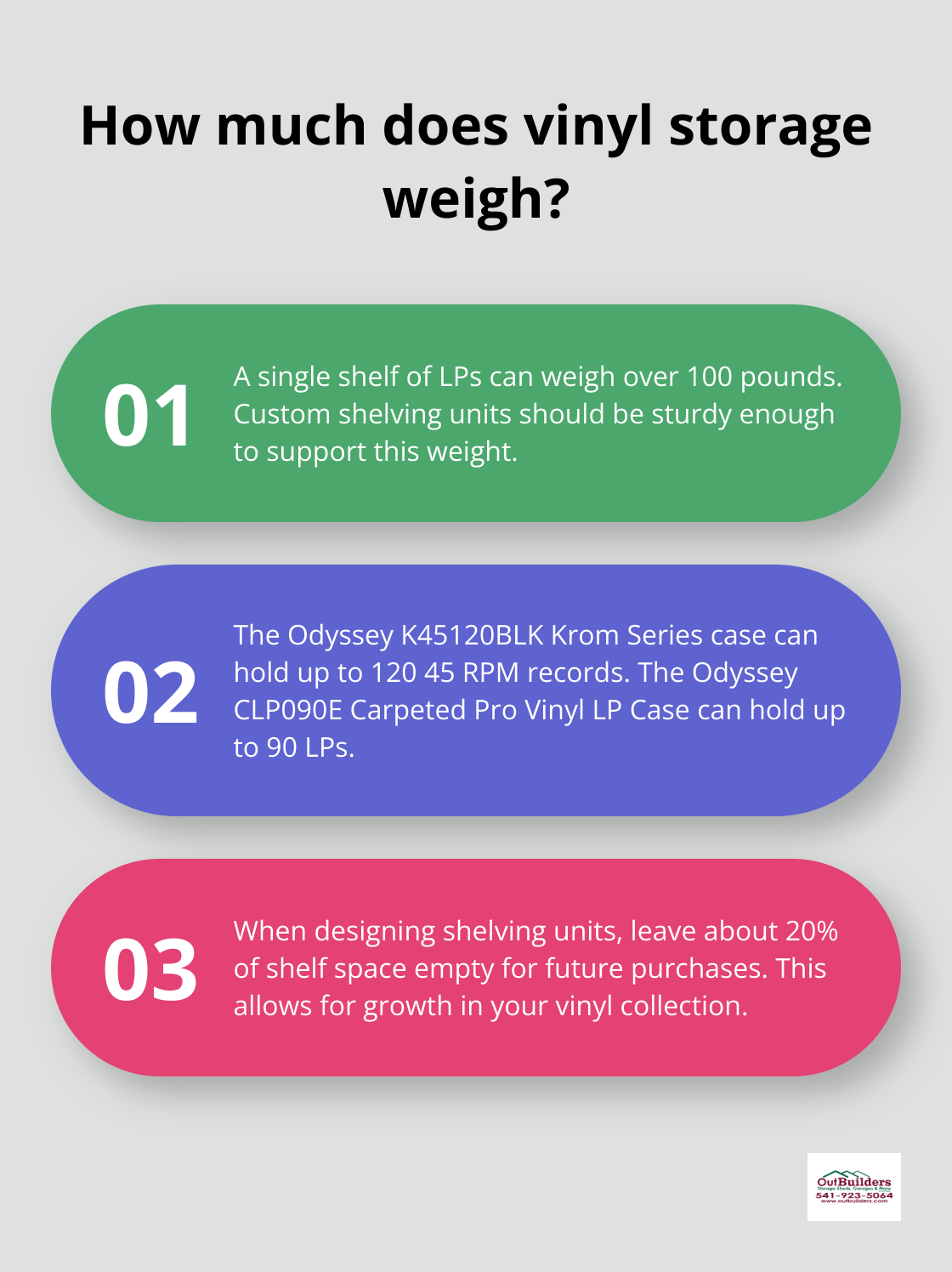
When you design your shelving unit, factor in room for growth. Leave about 20% of your shelf space empty to accommodate future purchases. Also, ensure the shelves are sturdy enough to support the weight of your records (a single shelf of LPs can easily weigh over 100 pounds).
Repurposed Furniture: Creative and Cost-Effective
For those on a budget or with a penchant for DIY, repurposed furniture can offer unique storage solutions. You can transform old dressers into stylish record cabinets with a few modifications. Remove the drawers, reinforce the interior with additional supports, and add dividers to create perfect slots for your albums.
Another creative option is to use vintage suitcases as portable record storage. These not only provide a charming retro look but also offer protection from dust and light. Just be sure to line the interior with soft fabric to prevent scratches on your album covers.
Portable Solutions for the Traveling Collector
If you’re a DJ or frequently travel with your records, you should invest in a high-quality portable case. Look for cases with reinforced corners, sturdy handles, and foam padding to protect your vinyl during transit. The Odyssey K45120BLK Krom Series case can hold up to 120 45 RPM records and features a lockable lid for added security.
For larger collections, consider a rolling flight case. These professional-grade cases often come with wheels and extendable handles, making it easier to transport heavier loads. The Odyssey CLP090E Carpeted Pro Vinyl LP Case is a popular choice, holding up to 90 LPs and offering excellent protection.
Custom Storage Solutions: Tailored to Your Needs
While there are many off-the-shelf options available, custom storage solutions offer unparalleled flexibility and style. Companies like Outbuilders specialize in creating bespoke storage units that not only protect your vinyl collection but also enhance your living space. Whether you need a dedicated vinyl room or a multi-purpose storage area, a custom solution can be designed to meet your specific requirements.
Custom storage solutions allow you to incorporate features like climate control, specialized lighting, and integrated sound systems. These tailored options ensure that your vinyl collection is not just stored, but showcased in a way that reflects your passion for music.
As we move forward, let’s explore how to properly handle and maintain your vinyl records to ensure they stay in pristine condition, regardless of your chosen storage solution.
How to Handle and Clean Your Vinyl Records
The Art of Handling Vinyl
Handle your records by the edges and the label area only. Never touch the grooves with your bare hands. The oils from your skin can attract dust and degrade sound quality over time. If you must touch the surface, use clean, lint-free gloves.
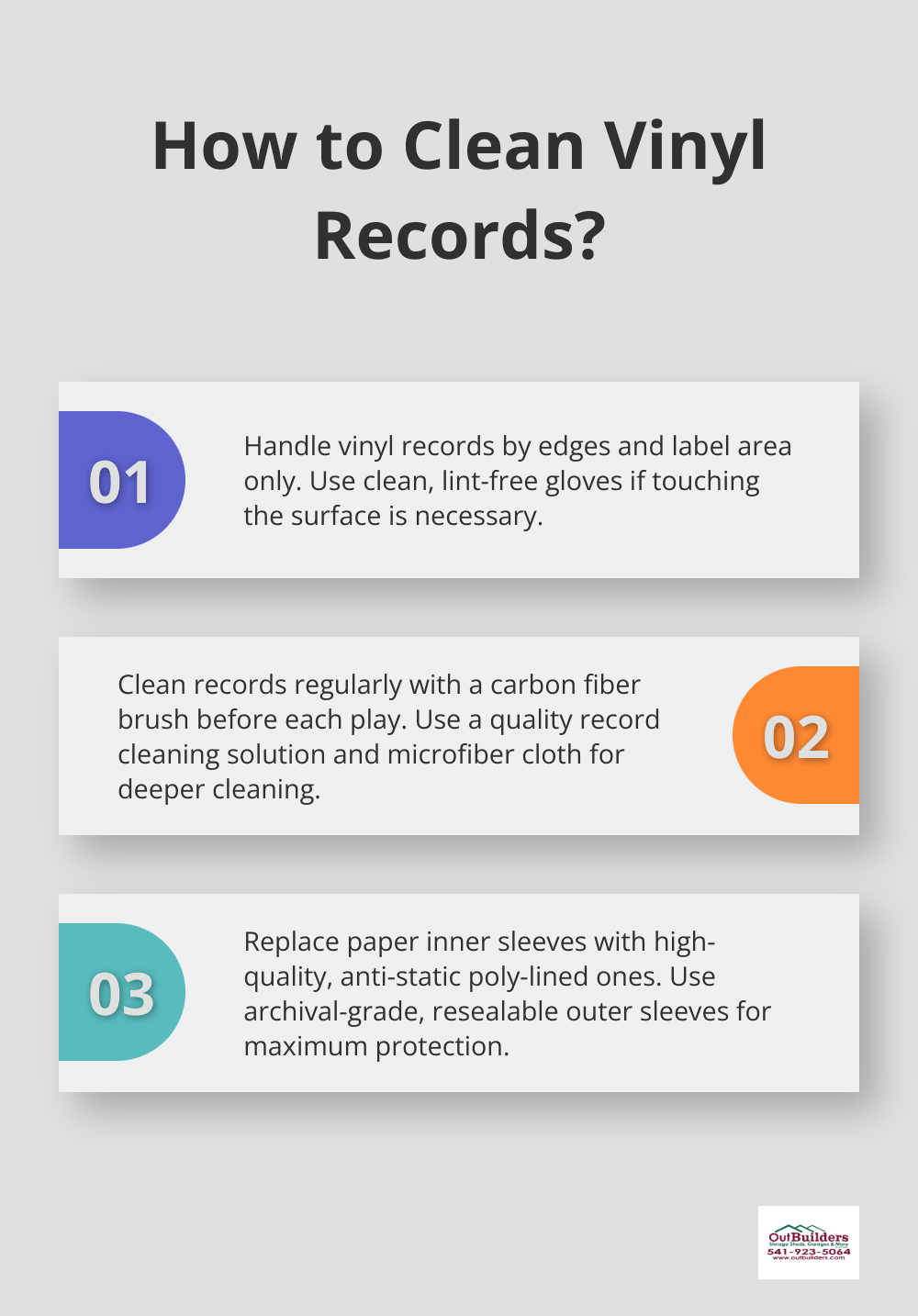
To remove a record from its sleeve, bow the sleeve slightly and let the record slide out into your hand. This technique minimizes contact with the record’s surface. When placing the record on the turntable, use both hands and lower it gently onto the platter.
Cleaning Your Vinyl Records
Clean your records regularly to maintain sound quality. Before each play, use a carbon fiber brush to remove surface dust. Place the brush gently on the record while it’s spinning and move it from the center to the outer edge.
For deeper cleaning, use a quality record cleaning solution and microfiber cloth. Apply the solution to the cloth (not directly to the record). Clean in circular motions, following the grooves. Avoid alcohol-based cleaners as they can damage the vinyl over time.
A record cleaning machine can be a worthwhile investment for serious collectors. The VPI HW-16.5 is highly regarded in the vinyl community.
The Importance of Quality Sleeves
Inner sleeves serve as your records’ first line of defense against dust and scratches. Replace paper sleeves with high-quality, anti-static poly-lined ones. Mobile Fidelity Sound Lab’s inner sleeves are an excellent choice.
Outer sleeves protect your album covers from wear and tear. Use archival-grade, resealable outer sleeves for maximum protection. These not only shield your covers from dust but also prevent ring wear caused by stacking.
Maintaining Your Storage Area
Maintain your storage area regularly. Dust your shelves or cabinets weekly with a microfiber cloth. If you use open shelving, consider covering your collection with a clean sheet when not in use.
Inspect your storage area monthly for signs of pests or mold. If you spot any issues, address them immediately to prevent damage to your collection. A small dehumidifier in your storage area can help maintain optimal humidity levels and prevent mold growth.
Final Thoughts
Proper vinyl album storage solutions protect your cherished record collection. Maintain optimal temperature and humidity levels, shield albums from light and heat, and keep them dust-free to ensure longevity. Invest in quality storage options like custom shelving, repurposed furniture, or portable cases to provide a solid foundation for protecting your records.
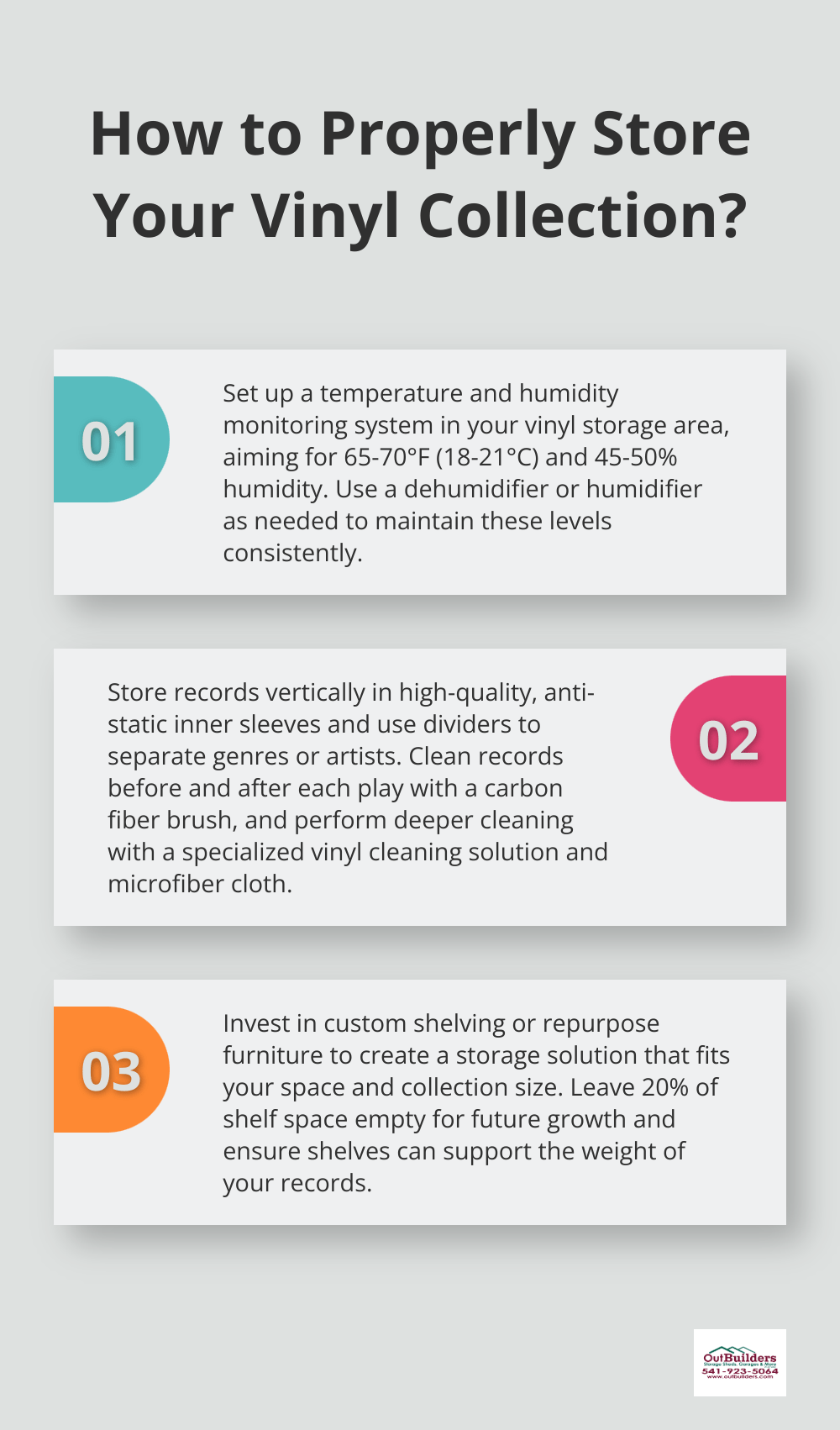
Handle your vinyl with care and implement regular cleaning routines to maintain sound quality. Use high-quality inner and outer sleeves to add an extra layer of protection against wear and tear. The effort you put into storing and maintaining your collection pays off in preserved sound quality and album longevity.
Custom solutions offer unparalleled protection and style for collectors who want to elevate their vinyl storage. At Outbuilders, we create bespoke storage units that safeguard your vinyl collection and enhance your living space. Our expert team designs and constructs custom cabinets, shelving units, or dedicated vinyl rooms (tailored to your needs and aesthetic preferences).

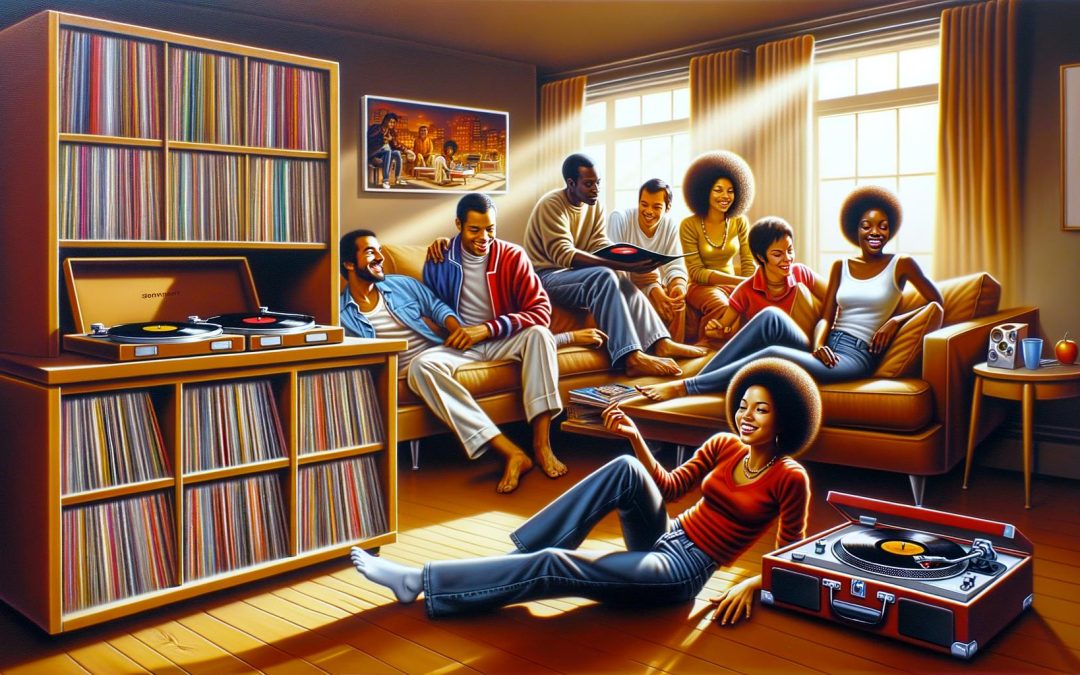





Recent Comments